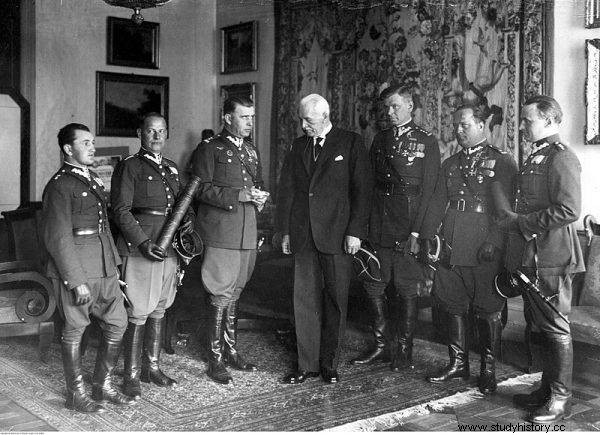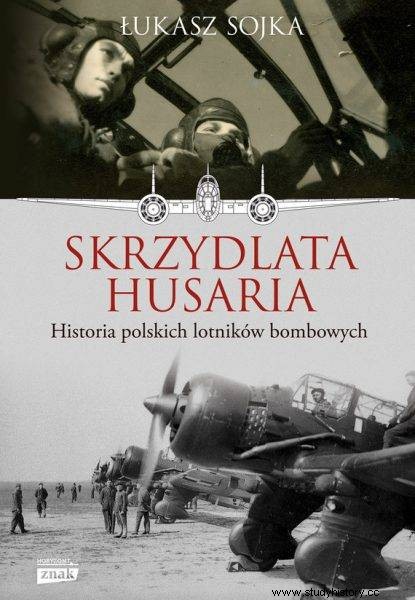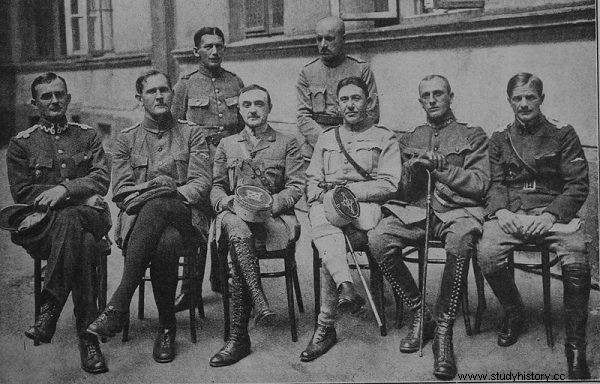At the end of May 1920, it seemed that the fates of Krzyżopol and Wapniarki were already a foregone conclusion. The Bolsheviks had terrible weapons - armored trains, steel giants, literally bristling with machine guns and cannons. However, the Poles reigned supreme in another field - in the air.
More than a year has passed since Operation Ride, during which everything has changed. On May 7, 1920, Polish troops entered Kiev, but not as invaders, but as allies of the Ukrainian People's Republic in the fight against the Bolsheviks. Soon Symon Petliura and his Ukrainian government appeared in the city.
Among the inhabitants of Kiev, which in recent months had changed hands between Ukrainians, Bolsheviks, Germans and "white" Russians, fatigue rather than enthusiasm prevailed. (...) Meanwhile, the Bolsheviks were gathering strength - from the beginning of the Polish-Ukrainian offensive, they withdrew, avoiding a battle, and now, when the opponent's impetus weakened, they were preparing a counterattack.
In the south, Polish troops moving along the railway line to the Black Sea took Wapniarka - an important junction station where the tracks from Lviv, Kiev and Odessa converged - and stopped 20 kilometers further in Krzyżopol.
On May 23, the Bolshevik counterattack was launched. The infantry, supported by four armored trains, tried to capture the station in Krzyżopol in five successive storms , thus opening the way to the north, but all attacks collapsed under the fire of the defenders. The Poles kept the front line, but it was clear that the enemy would try his luck again (...).
The commander of the 6th Army of the Southern Front - General Wacław Iwaszkiewicz-Rudoszański - had only one armored train in this section, named "Iwaszkiewicz" in his honor. It seemed that in the face of Bolshevik domination on the tracks, the fate of Krzyżopol and Wapniarki were already a foregone conclusion, but the Poles reigned supreme in another field - in the air.
Strong on paper
In the spring of 1920, the Polish air force had already settled down after the initial creative chaos. (...) The former air groups were renamed air squadrons, which usually consisted of several squadrons for various purposes. The 3rd Air Squadron, derived directly from the 3rd Air Group, was assigned to the 6th Army operating in the southern section of the front (...).

Delegation of the 3rd Air Regiment at the audience with the President of the Republic of Poland Ignacy Mościcki
On paper, these were quite a lot of force, but after a few weeks of intense action, the reality was much less impressive. The 6th and 17th squadrons were practically excluded from operations - the 6th was waiting for the delivery of De Havilland DH-9 machines ordered from England and the 7th has used up its French Breguets to such an extent that it is impossible to use them any further.
So there were three more squadrons left, transferred to the airport in Rachny Lesowe. These were:the 5th Intelligence Squadron with two operational machines (DFW C-V or LVG), the 15th Fighter Squadron with five Fokkers D-V and one Albatros B-II, and the 21st Destroyer Squadron with a twin-engine Goth bomber and two operational single-engine AEG C-IV bombers.
When the fighting for Krzyżopol broke out on May 23, 1920, the 3rd Division had only 11 aircraft - mostly fighters or light multipurpose machines, which could only counter the Bolshevik battleships with machine guns and bombs weighing a maximum of 12 kilograms dropped by a pilot or an observer. The exception was the 21st Destruction Squadron with the only real bomber in the entire squadron (...).
Aerial chauffeurs
The creation of a real bomber squadron was an idea that had to appear almost from the beginning of the aviation of independent Poland, but it was only the energy and determination of Lieutenant Rayski that made it materialize in the form of the 21st Destruction Squadron . (...) She started forming on April 15, 1920. Rayski became so involved in its creation that he himself designed the emblem of the individual - a stylized anagram of N.E.L. against a white and red chessboard.
The beginnings were not easy - just completing the crews turned out to be a real problem. Young people graduating from aviation school almost as one husband wanted to become fighter pilots - figures shrouded in a halo of chivalry, radiant with the fame of their predecessors fighting fierce but honorable battles over the Western Front of World War I.
The bomber pilot was then associated with an air "chauffeur", doomed to obey the observer's orders, because in the Polish aviation the observer was in command of the plane. So there were people like Janusz Meissner, who refused Rayski to train on fighters. In the end, however, the necessary flying personnel was assembled, which was only half the success. For the squadron to function, the pilots had to fly on something, and the equipment was still fragile.

The text is an excerpt from Łukasz Sojka's book “Winged husaria. The history of Polish bomber pilots ", which has just been released by the Znak Horyzont publishing house.
The only real destructive machine that the Polish air force had at that time was Gotha with the serial number 213/17, changed in Poznań to 100/17. Although Rayski had commanded a single-plane squadron once - the Odessa Breguet, which was for a while the only machine of the 10th Squadron - he did not intend to repeat this precedent with the 21st Destruction Squadron.
However, it was not as easy to find bombers as it was to find fighters or airplanes, which the invaders had abandoned at bases all over the country. You could buy them overseas or get them through the Allied Reparation Commission, which dealt with the separation of Prussian and Austro-Hungarian property.
Finally - you could also wait for another Gotha to land somewhere in Poland, and the crew would not have time to burn it. All of this, however, required a time that Rayski was not going to waste. Therefore, the squadron next to the Gothy 100/17 included six AEG C-IV light airliners from which observers could manually drop small bombs.
Defeat the "armored"
And so, 7 planes, 6 officers, 11 non-commissioned officers, 112 privates, 10 horses, 10 cars, 6 cars, and a supply of bombs, ammunition, lubricants, fuel, spare parts and tools were loaded onto railway wagons and on the last day of April 1920 21. The Destroyer Squadron set off on a two-week journey to the front.
For Rayski, it meant the end of command of the Higher School of Pilots, as he was the commander of the first Polish bomber unit, which on May 15 took the airport in Rachny Lessowyje, becoming at the same time part of the 3rd squadron commanded by Captain Stefan Bastyr.

The convention of commanders of air groups in 1919.
The actions of the "destroyers" started unlucky - on the first day one of the AEG C-IV had to land forcibly on the Soviet side of the front due to engine failure . (...) The failure rate of AEG planes soon led to a situation in which the 21st Squadron usually had efficient Gotha and 1-2 single-engine planes. This was also what her possession was when she started her first serious bombing missions on May 24 (...).
The task of aviation was simple - to shoot and bombard armored trains to damage them and absorb their crews enough for the infantry to approach them and start the assault. For Gotha - the only machine capable of carrying 50 kilograms bombs - a special place was provided in this plan.
Goth's first attack was made at dawn on May 27, around 5:00. The target was the Malevannaja station - an easily identifiable object that would ensure that even taking into account the spread, something important could be hit. The dropped bombs damaged the trains and tracks standing at the station, and a moment after the destroyer, the remaining planes appeared, bombing the station area again. At around 7:00 the railroad connection was severed, but the attack continued.
On the edge
Now - about three and a half hours after the first raid, when Gotha was armed again, refueled, engines checked and oils and greases topped up - the machine piloted by Ludomil Rayski once again flew majestically over the Rudnycia station.
Lieutenant Czesław Filipowicz waited for the right moment with his eye glued to the scope of the sight. Finally, when an intact section of track was found at the intersection of the threads, the bombardier pressed a set of release levers . (...) Freed from the weight of 300 kilograms of bombs, Gotha lay down on the wing in the headland.
Filipowicz leaned over the side, trying to find the places where the missiles had fallen. Rayski, on the other hand, gripped the tiller wheel as he steered the large bomber towards the base. He did not know yet that they had managed to block the station and that during the operation on May 27, 1920, the soldiers of the 12th Infantry Division would seize two Soviet armored trains - the destroyed "Towariszcza Bela Kun" and a functional "Krasny Kriestianina" - and the 3rd Division would not lose a single aircraft, contributing significantly to the success achieved that day.
He also did not know that the next day he and Filipowicz would bomb the Polish infantry unit, which would not lay out the identification sheets, and that the conducted investigation would free him and the observer from responsibility. He also did not know that the actions of the Bolsheviks in the Krzyżopol region were one of the elements of the great offensive which will throw Poles as far as Lviv and Warsaw, putting young, independent Poland on the brink of extermination.
And finally, that the 21st Destruction Squadron will be fighting at that time with Budyonny's Konarmia, supporting the Polish troops retreating to the west, but at the key moment of the fight for Lviv and the Battle of Warsaw, it will be defeated by technical problems and the dysentery epidemic.
Source:
The text is an excerpt from Łukasz Sojka's book “Winged husaria. The history of Polish bomber pilots ", which has just been released by the Znak Horyzont publishing house.
